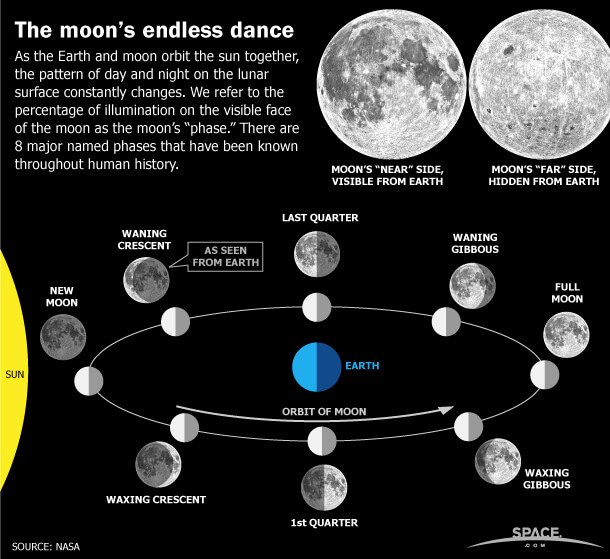
Moon phases reveal the passage of time in the night sky. Some nights when we look up at the moon, it is full and bright; sometimes it is just a sliver of silvery light. These changes in appearance are the phases of the moon. As the moon orbits Earth, it cycles through eight distinct phases. The four primary phases of the moon occur about a week apart, with the full moon its most dazzling stage.
In February 2022, the moon’s phases will occur on the following dates:
New Moon: Feb. 1
First Quarter: Feb. 8
Full Moon: Feb. 16
Last Quarter: Feb. 23
LUNAR CALENDAR FOR 2022
Here are the moon phases for 2021, according to NASA’s SKYCAL. Times and dates are in UTC time. If you need equipment for viewing the moon, check out our guide to the best telescopes and the best telescopes for kids.
You can also check out our guide on how to photograph the moon, as well as how to photograph a lunar eclipse for major moon events. There’s even a guide on how to photograph a solar eclipse.
If you’re looking for imaging gear, our best cameras for astrophotography and best lenses for astrophotography guides can help prepare you for the next lunar sight.
| New Moon | First Quarter | Full Moon | Last Quarter |
|---|---|---|---|
| Jan 2, 1:33 p.m. | Jan. 9, 1:11 p.m. | Jan. 17, 6:48 p.m. | Jan. 25. 8:41 a.m. |
| Feb. 1, 12:46 a.m. | Feb. 8, 8:50 a.m. | Feb. 16, 11:57 a.m. | Feb. 23, 5:32 p.m. |
| March 2, 12:35 p.m. | March 10, 5:45 a.m. | March 18, 3:17 a.m. | March 25, 1:37 a.m.. |
| April 1, 2:24 a.m. | April 9, 2:48 a.m. | April 16, 2:55 p.m. | April 23, 7:56 a.m. |
| April 30 4:28 p.m. | May 8, 8:21 p.m. | May 16, 12:14 a.m. | May 22, 2:43 p.m. |
| May 30, 7:30 a.m. | June 7, 10:48 a.m. | June 14, 7:52 a.m. | June 20, 11:11 p.m. |
| June 28, 10:52 p.m. | July 6, 10:14 p.m. | July 13 2:37 p.m. | July 20,10:18 a.m. |
| July 28, 1:55 p.m. | Aug. 5, 7:06 a.m. | Aug. 11, 9:36 p.m. | Aug. 19, 12:36 a.m. |
| Aug. 27, 4:17 a.m. | Sept. 3, 2:08 p.m. | Sept. 10, 5:59 a.m. | Sept. 17, 5:52 p.m. |
| Sept. 25, 5:54 p.m. | Oct. 2, 8:14 p.m. | Oct. 9,.4:55 p.m. | Oct. 17, 1:15 p.m. |
| Oct. 25, 6:49 a.m. | Nov. 1, 1:37 a.m. | Nov. 8, 6:02 a.m. | Nov. 16, 8:27 a.m. |
| Nov. 23, 5:57 p.m. | Nov. 30, 9:36 a.m. | Dec. 7, 11:08 p.m. | Dec. 16, 3:56 a.m. |
| Dec. 23, 5:17 a.m. | Dec. 29, 8:20 p.m. |
PHASES OF THE MOON
The moon, like Earth, is a sphere, and it is always half-illuminated by the sun. As the moon travels around Earth, we see more or less of the illuminated half. Moon phases describe how much of the moon’s disk is illuminated from our perspective.
New moon: The moon is between Earth and the sun, and the side of the moon facing toward us receives no direct sunlight; it is lit only by dim sunlight reflected from Earth.
Waxing crescent: As the moon moves around Earth, the side we can see gradually becomes more illuminated by direct sunlight.
First quarter: The moon is 90 degrees away from the sun in the sky and is half-illuminated from our point of view. We call it “first quarter” because the moon has traveled about a quarter of the way around Earth since the new moon.
Waxing gibbous: The area of illumination continues to increase. More than half of the moon’s face appears to be getting sunlight.Advertisement
Full moon: The moon is 180 degrees away from the sun and is as close as it can be to being fully illuminated by the sun from our perspective. The sun, Earth and the moon are aligned, but because the moon’s orbit is not exactly in the same plane as Earth’s orbit around the sun, they rarely form a perfect line. When they do, we have a lunar eclipse as Earth’s shadow crosses the moon’s face.
Waning gibbous: More than half of the moon’s face appears to be getting sunlight, but the amount is decreasing.
Last quarter: The moon has moved another quarter of the way around Earth, to the third quarter position. The sun’s light is now shining on the other half of the visible face of the moon.
Waning crescent: Less than half of the moon’s face appears to be getting sunlight, and the amount is decreasing.
Finally, the moon is back to its new moon starting position. Now, the moon is between Earth and the sun. Usually the moon passes above or below the sun from our vantage point, but occasionally it passes right in front of the sun, and we get a solar eclipse.
– Advertisement –